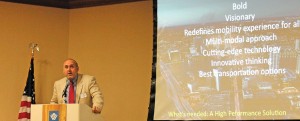Stars are aligned for Southbank changes
Posted on February 5, 2013 By Editor Articles, Neighborhood News, Top Stories
Residents want to halt proposed BRT development
The turnout was much better than expected at the first gathering of Southbank residents and business owners to discuss the Jacksonville Transit Authority’s plans for Bus Rapid Transit lanes along Riverplace Boulevard.
The meeting of an estimated120 people was held at the Wyndham Hotel late last month to present an alternate vision of transportation and infrastructure development primarily along Riverplace Boulevard. Brad Wallace, a Southbank resident and neurosurgeon at Baptist Health opened the meeting “by and for residents of the Southbank area who have invested in an area that has the most beautiful downtown in the United States.”
Wallace also noted that the economic downturn – among other reasons – thwarted the momentum to turn the Southbank into a destination rather than a thru-way. Those other reasons include a lack of Downtown residents and a lack of cohesive effort on common goals and understanding how to affect change. “The stars are finally properly aligned to achieve change in Southbank,” he said. “The one significant issue, however, are the plans to implement Bus Rapid Transit (BRT) on Riverplace Boulevard.
The alternate vision for Riverplace Boulevard was actually created back in 2009-2010 by Chris Flagg, chair of Downtown Vision Inc. (DVI) and president of Flagg Design Studio. A landscape architect by profession and urban designer by trade, Flagg presented before and after photographs and renderings of Prudential Drive and Riverplace Boulevard in two phases of enhancements and improvements.
“There are a lot of opportunities for aesthetic embellishments along these streets,” Flagg noted. “There’s just tremendous potential to improve Southbank.”
Phase 1 of the enhancements could include a streetscape, with trees, lighting, banners, utility box screen, buffers, on-street parking and sidewalk improvements, while greater and more costly improvements in Phase 2 would include intersection improvements such as roundabouts, landscaped medians, branding of Southbank, particularly with the Skyway, and creating an ambience conducive to pedestrians and bicyclists.
Following Flagg’s presentation, Steve Lovett, principal with the environmental design firm ELM Studio, offered real city examples of the
investment that high-performance infrastructure can return to a community that is ready to take that step. The performance factors that are affected by investment in the right infrastructure include social, economic, cultural, aesthetic, functional, ecological and health performances. “Riverplace Boulevard should be designed for people and encourage street level activity,” he said. “It should not be built for speed. I believe it will be a model for other urban streets in Jacksonville and in the nation.”
Unfortunately, the JTA’s vision for the Southbank includes the use of a “fossil-fueled, rubber-tired” transit system, according to Lovett. That vision is predicated on an $18 million federally funded project as long as there is a minimum of 20 percent dedicated lanes to mass, rapid transit.
Doug Skiles, owner of EnVision Design+Engineering and past president of the San Marco Preservation Society, presented the cons of moving forward with the BRT as planned. His diagrams showed the redundancy of the proposed busway with the current Skyway route and stops; the risky result of creating a 90-foot intersection across five lanes of traffic; and the increased potential for fatal accidents along a 40 mph-plus stretch. And, timing is critical. “Once the government releases the funds and construction starts, there’s no going back,” he cautioned.
Skiles conducted an unofficial and nontechnical study of traffic patterns at the same time on two mornings along the five-lane Riverplace Boulevard and along Hendricks Avenue, which has three lanes and lower speed limit. There were 53 vehicles which traversed both roadways between 8 a.m. and 8:30 a.m. The average speed on Hendricks Avenue was actually slightly higher (by 1.4 mph) than along Riverplace Boulevard, which has more stoplights.
“There is definitely no need for dedicated bus lanes,” Skiles said. “According to my study, it would only save 10 seconds per trip.”
Ron Moody, CEO of Broom, Moody Johnson & Grainger, real estate appraisers and consultants, spoke briefly on the impact that a BRT would have on real estate in the Southbank area. “It will not drive up home values,” he indicated starkly.
Members in the audience wondered what was next. “We need to communicate ‘Stop BRT’ to the JTA,” said Wallace during the closing of the meeting. “There is new leadership in the JTA who are interested in community feedback. We need to organize as a community.”
Next steps for this group include another meeting to create a master community “wish list” of enhancements, prioritization of items for feasibility and impact, and organization of efforts to work with public officials. Wallace indicated that there were beautification funds available through the Downtown Investment Authority but a plan must be presented.




 (No Ratings Yet)
(No Ratings Yet)





